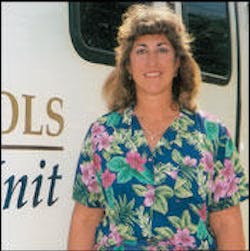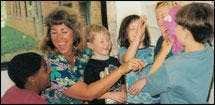Mobile Force One
This hygienist is on a mission: Ensuring that every child in her Ohio town receives quality dental care. As you might guess, she's on the road much of the time.
by Cathy Hester Seckman, RDH
Every February it's the same story. Someone from your child's school calls — usually on the last day or two of the month. "We're supposed to do a dental unit this month. Could you come in tomorrow and talk to the kids? Maybe bring some toothbrushes?" You moan and groan and drag out the moth-eaten Tooth Fairy costume someone from your unit made 15 years ago. You rush down to the school, put on your happy face and talk to the kids about brushing and flossing.
As you leave, you wonder — shouldn't there be a better way to do this?
Valencia Clark is a 20-year veteran of that endangered species, the school hygienist. She is employed full-time by the Zanesville, Ohio School District as a dental hygienist/teacher. Clark has a bachelor's degree in education and a master's in curriculum, as well as an associate's in dental hygiene.
"I spend half my time in the classrooms," she says, "talking about nutrition, tobacco use, dental education, sealants, and fluoride. In the middle and high schools, I even talk about baby nutrition because we have our share of pregnant teens. The rest of my time is spent right here."
"Here" is a brand-new, $114,000 operatory on wheels that any hygienist would be proud to claim. The mobile dental unit is nestled up behind Munson Elementary School in a blind alley equipped with an outdoor water spigot and an electrical outlet. Each of Zanesville's 11 school buildings has a similar set-up. Clark visits each school on a regular basis with her mobile unit, seeing tiny patients who greet her with, "Hey, the Tooth Lady's here!"
Children who fall under certain income guidelines qualify for free dentistry through the school district. Clark does prophys and fluoride treatments, places sealants, takes X-rays, and performs exams right in the unit. Because she is employed by a school district instead of a dentist, Clark is exempt from the laws that typically prevent a hygienist from practicing without a dentist. The Ohio Dental Board has always allowed her to work autonomously.
The unit is as complete as any operatory. At the back are a patient chair, two operator's stools, a wall-mounted X-ray unit, and a delivery cart. Cupboards that hold an autoclave, an ultrasonic cleaner, a portable X-ray developer, and every necessary supply line the center of the unit. A small sink has its own hot water heater; the unit also has its own furnace, air conditioner, and holding tank. More supply cupboards are at the front, along with a radio, television, and a VCR.
Because it is basically a pediatric practice, some of the cupboards are filled with big plastic typodonts, toothy puppets that squirt water, stickers, toys, sunglasses, and free samples. Clark gives out more than 4,000 toothbrushes and a thousand samples of floss every school year. Between classroom instruction and individual exams, she sees each of the district's 4,900 students at least once a year. She also sees 350-450 of them for more extensive dental treatment during a typical school year.
A pediatric dentist, Dr. David Maddox, joins her for 40 days each school year to do restorations, root canal therapy, extractions, and crowns. "Actually, I work for her," he admits cheerfully. Dr. Maddox has been the school district's dentist since 1956. A native of nearby Roseville, Ohio, he was completing an internship in Rochester, N.Y., when he got the offer to return to Zanesville as the school's dentist. He's been there ever since, maintaining a private practice as well.
"It's a worthwhile cause," he said. "Keeping schoolchildren free of pain is paramount. Toothaches have always been a thing that causes absenteeism, and that's how the program really got started — too many kids were missing school because of toothaches."
Zanesville is biased, Dr. Maddox says proudly, believing its school dental program is one of the best anywhere. As Clark puts it, "We think we're pretty hot stuff." He adds, "It's a way to see kids who don't get treated. Their parents are the working poor who can't provide things that aren't a top priority. It's hard enough just to get food, clothing, and shelter."
Where else could a child break a tooth on the playground and have it fixed before his parents even knew it had happened? "One of our kids broke a front tooth at recess," Clark recalls, "and his parents were out of town. We got his grandmother down to the school, and I called Dr. Maddox and said, 'We need you right now!' There we were — Grandma, the doctor, the kid, and me out in the playground looking for the broken piece. We found it, put it back on, and he looked as good as new by the end of the day.
"We had another girl once who had two decayed central incisors. Esthetics and self-esteem are really important for kids. She was quiet, didn't smile, didn't participate. After we fixed her teeth, she was a whole new person. I like to think we made a real difference in her life."
Stories like that make Clark feel her efforts are worthwhile. "The kids trust me, and there's continuity in their seeing me. I feel very lucky in what I do."
Cathy Hester-Seckman, RDH, is a frequent contributor who is based in Calcutta, Ohio.
Have van, will travelZanesville is an ordinary river community of 26,000, no different from other midwestern cities. How did its school system get to this point, with a full-time hygienist on staff and a state-of-the-art mobile dental unit? Why are its schoolchildren so much better served dentally than other schoolchildren?Some of the credit can go to Valencia Clark and Dr. David Maddox, but the story started well before their time. In 1942, community leaders in Zanesville recognized how badly the schoolchildren needed dental treatment. The Soroptimists, a women's service club, and a local dentist raised funds to provide limited dental exams in schools. In 1950, they purchased a trailer outfitted with dental equipment that was pulled by truck from school to school.
When Dr. Maddox arrived in 1956, extractions were common and toothbrushing instruction wasn't. "When I first came to town, they talked about treatment all the time, but I said, 'It has to be education.' That was a hard sell. When I made presentations to the principals, I stressed that we need to prevent cavities, not just treat them. That's what we've evolved to today, education. Treatment is just a small part of it."
The trailer was replaced by a 23-foot van in 1973. In 1980, Nancy Brughagen was the school's popular hygienist. Clark, whose father was Zanesville's school superintendent, was just finishing her bachelor's degree and was looking forward to finding a job like Nancy's. When Nancy was killed tragically in an accident, Clark was interviewed and hired for her own home school district, and she's been there ever since.
"It's been a wonderful ride," she says. "I've gotten to do both, teach children and clean teeth. I like the combination.
"Plus, I set up, clean up, drive the unit, do public relations, assist the doctor, write the reports — I take care of everything."
Her salary — and Dr. Maddox's stipend — are paid by the school district; the Soroptimist Club has been providing all of the program's supplies for nearly 60 years. The new mobile unit? Well, Clark bought that — with help from nearly every club, lodge, service organization, and association for miles around.
"Our old van was falling apart," she recalls. "The guys at the bus garage told me they just couldn't fix it anymore. I went to the superintendent and said, 'We need a new van.' Basically, he just said, 'Good luck.' 'If I go out and raise money,' I asked him, 'can I spend it on a new mobile unit?' He agreed, probably thinking I wouldn't really go out there, but he ought to have known better."
She typed some proposals, brushed up her public speaking skills and hit the road, spending a year giving speeches to anyone who would have her. "I even wrote to people — I wrote to Bill Gates, to Oprah, to Rosie. I'd say, 'Look what we have, look what we're doing. Don't you want to be a part of that?'"
Eventually, 23 groups donated $114,000 for the new unit. The Soroptimist Club alone came up with $30,000. The American Dental Association supplied the names of manufacturers who build mobile medical units, and Clark settled on the Lifeline Co. in Groveport, Ohio. They built the unit to her specifications, and it was placed in service in January 2001.
"We're so fortunate to have this," she says with a proprietary air. "Look what we have, and just imagine if all school districts had this. It's even gotten us some notice around the country. Other educators want to come and see the unit. I've given tours to people from Missouri, New York, Pennsylvania, and the Cleveland Clinic."
Credit for the fundraising project's success goes to Clark, says Tony Reese, the school's director of Title I and Special Programs, who also is her immediate supervisor. "We can see what a tremendous job she does by looking at the support she got for the new mobile unit. We get nothing but positive feedback from the parents and teachers. As a parent myself, I've always thought the program was worthwhile. It's very unique in schools."



